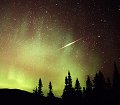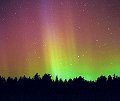
|
back to spaceweather.com |

|
|
Summary: An interplanetary shock wave swept past Earth around 1000 UT (6:00 a.m. EST) on May 11th and triggered a G2-class geomagnetic storm. Sky watchers in Canada and across the northern tier of US states spotted auroras for the next three days as solar wind gusts buffeted Earth's magnetic field. |
| Photographer, Location | Images | Comments | |
 |
Paul Wicklund,
near Colbert, Washington, USA May 14 |
#1, #2, #3, #4, more | Photo details: Kodak Ultra 400 with 30 second exposures |
 |
Carol Lakomiak,
Tomahawk, Wisconsin, USA May 13 |
#1, #2 | Photo details: "Olympus OM-1n with 28mm Zuiko at 2.8 using 400 ISO Kodak Max." |
 |
Dominic
Cantin, 75 km north of Quebec City, Canada, in the Laurentides
wildlife reserve May 12 |
#1, #2, #3, #4, #5, #6 | Image #1 shows an Iridium satellite (visual magnitude -6) behind the auroras. Several others include Venus and Mars, which appear as a bright "double star" near the horizon. Photo Details: 28 mm @ f 2.8 , ~ 25 sec, Fuji Superia 800 |
 |
Paul Wicklund,
Mead, Washington, USA May 12 |
#1, #2, #3, more | P. Wicklund: "These faint horizon-hugging auroras appeared from 12 am until 2 am local time over eastern Washington. The photos were taken north of Spokane near Fan Lake. The exposures were approximately 30 seconds taken on Fuji 400 speed film." |
 |
Darren
Talbot, Halifax, Nova Scotia May 11 |
#1, #2, more | D. Talbot captured these images from the Halifax Chapter of the Royal Astronomical Society of Canada's St Croix Observatory, in Nova Scotia. Photo details: Pentax ME Super with a 28mm f/2.8 wide angle lens. Exposures varied from 20 secs to 1 minute on Fujicolor 400 film." |
 |
Philippe
Moussette, St-Elzéar, Québec, Canada May 11 |
#1, #2, #3, #4, more | Photo details: Coolpix 995 digital camera, 30s exposure, 400 asa. |